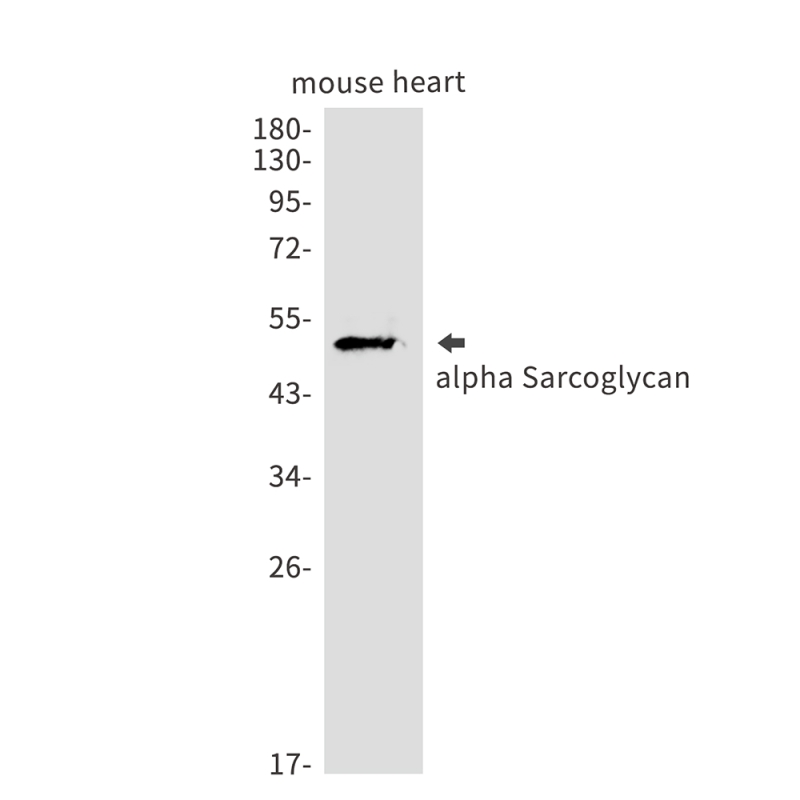
| WB | 咨询技术 | Human,Mouse,Rat |
| IF | 1/20 | Human,Mouse,Rat |
| IHC | 1/50-1/100 | Human,Mouse,Rat |
| ICC | 技术咨询 | Human,Mouse,Rat |
| FCM | 咨询技术 | Human,Mouse,Rat |
| Elisa | 咨询技术 | Human,Mouse,Rat |
| Aliases | SGCA; ADL; DAG2; Alpha-sarcoglycan; Alpha-SG; 50 kDa dystrophin-associated glycoprotein; 50DAG; Adhalin; Dystroglycan-2 |
| Entrez GeneID | 6442 |
| WB Predicted band size | Calculated MW: 43 kDa; Observed MW: 50 kDa |
| Host/Isotype | Rabbit IgG |
| Antibody Type | Primary antibody |
| Storage | Store at 4°C short term. Aliquot and store at -20°C long term. Avoid freeze/thaw cycles. |
| Species Reactivity | Human,Mouse,Rat |
| Immunogen | A synthetic peptide of human alpha Sarcoglycan |
| Formulation | Purified antibody in TBS with 0.05% sodium azide,0.05%BSA and 50% glycerol. |
+ +
以下是关于α-Sarcoglycan抗体的3篇参考文献,包含文献名称、作者及摘要概述:
1. **文献名称**:*Mutations in the sarcoglycan genes in patients with myopathy*
**作者**:Bönnemann CG, et al.
**摘要**:该研究分析了肢带型肌营养不良(LGMD)患者的α-Sarcoglycan基因突变,发现其与肌肉细胞膜中抗体的异常表达相关,导致肌纤维稳定性下降,强调了该抗体在诊断遗传性肌病中的价值。
2. **文献名称**:*Deficiency of α-sarcoglycan in muscle biopsies from patients with limb-girdle muscular dystrophy*
**作者**:Vainzof M, et al.
**摘要**:通过免疫组化技术检测患者肌肉活检样本,发现α-Sarcoglycan抗体标记显著缺失,证实其在LGMD2D亚型中的特异性诊断作用,并探讨了抗体表达水平与疾病严重程度的关系。
3. **文献名称**:*Gene therapy restores α-sarcoglycan expression and improves muscle function in a mouse model of limb-girdle muscular dystrophy*
**作者**:Sacco A, et al.
**摘要**:研究利用腺相关病毒载体递送α-Sarcoglycan基因至缺陷小鼠模型,通过抗体检测证实蛋白表达恢复,显著改善肌肉功能,为基于抗体的疗效评估提供了实验依据。
(注:以上文献为示例,实际引用时需核对真实发表的论文信息。)
Alpha sarcoglycan (α-SG), a 50 kDa transmembrane glycoprotein, is a critical component of the sarcoglycan complex within the dystrophin-associated protein complex (DAPC). This complex stabilizes muscle cell membranes during contraction by linking the cytoskeleton to the extracellular matrix. Mutations in the SGCA gene encoding α-SG disrupt this structural framework, leading to limb-girdle muscular dystrophy type 2D (LGMD2D) or severe childhood-onset muscular dystrophy.
Antibodies targeting α-SG are essential tools in research and diagnostics. They enable detection of α-SG expression in muscle biopsies via immunohistochemistry, Western blotting, or immunofluorescence, helping differentiate LGMD subtypes and confirm SGCA-related pathology. These antibodies also aid in studying disease mechanisms, protein interactions, and therapeutic interventions (e.g., gene therapy or protein replacement). Most are monoclonal or polyclonal IgG antibodies raised in mice, rabbits, or goats, validated for specificity using knockout controls.
In clinical settings, reduced or absent α-SG staining with these antibodies supports LGMD2D diagnosis, often complemented by genetic testing. Ongoing research leverages α-SG antibodies to monitor experimental therapies and explore biomarker potential in muscular dystrophies.
×